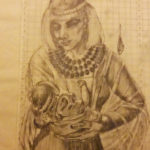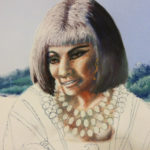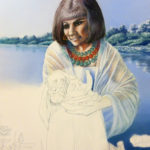THE LAST OF THE “WOMEN’S STUDIES” ART AND EDITING THE MANUSCRIPT
Well, it’s done. Last week I completed th e last of my paintings for “Women’s Studies”, number 12. She is “Pharaoh’s Daughter.” I had a few little issues with painting her, but overall, it wasn’t bad. Doing the calligraphy for her was amazing. I lined it all out, inked in the title, filled in the text, and completed the border, all without making a single mistake. That was truly a first for me, and also a miracle! Now I must move on to rewriting my manuscript and getting that ready for the final editing. This is not my favorite cup of tea! It is, however, something that must be done if I am to have a good quality, well-written book. So, onward!
With that in mind, I want to say a few words to aspiring writers out there. First of all, I read many, many books. Some are good, some bad. The writing makes the difference in many cases! A well written book will hold my interest, but a poorly written one quickly becomes boring. I can’t make myself finish reading a boring book. One that may have interesting subject matter, but is written so “scholarly” also becomes a dusty old tome on the shelf rather than a valuable addition to my library.
It was not until I got to the editing process of my manuscript that I began to realize so many mistakes new writers make, because I was making those same mistakes! After listening to some webinars from noted authors, I took their advice. I downloaded an editing app on my computer. The one I’m using is called “Hemingway” and is a free download, or you can pay a minor fee to purchase it and get free upgrades to the app as new versions come out. I paid the price for future upgrades. This thing has proved invaluable in improving the flow of my writing, its readability, and sentence structure. I had no idea it could make such a difference! There are other editing apps out there, too.
Now, it won’t tell you when you’re going off the main subject on tangents. It won’t correct redundancy or spelling errors. And it certainly won’t cut out unnecessary words, phrases, or sentences. You will need human eyeballs for those! (I transferred my manuscript back to MS Office Word for spellcheck.) But an editing app will help save your editor much time correcting mistakes you could’ve done yourself. Human editing is costly. It is priced out by the word count in the manuscript. Who wants to pay for words an editor will cut out? These apps will force you to rewrite in a more concise manner, lowering your word count. Any words eliminated before an editor sees it will lower your bill and make their job much easier and faster. Who doesn’t want that?
On top of all that, it will make you become much more aware of common mistakes and avoid them in your future writing!
Some words of caution: Don’t get so carried away by an app ruled by algorithms that you lose your writing style and personality. It’s OK to ignore a few things the app will tell you to change. Use common sense. Read up on your app to see what it does and doesn’t do, and break the “rules” where you feel it is necessary to retain the integrity of your work.








Recent Comments